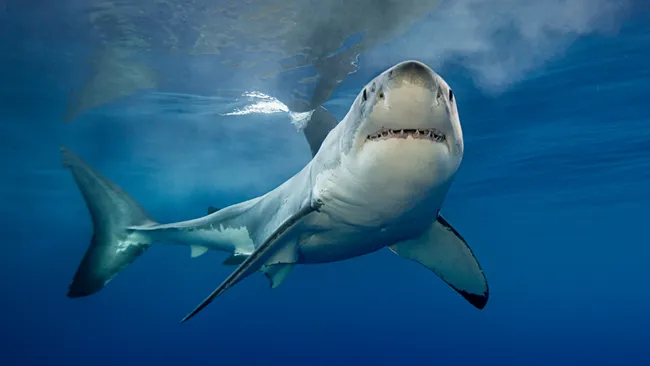Long portrayed in pop culture as scary beasts, real sharks are no Hollywood monsters. Sharks are a diverse group of mostly predatory fish. They do not have bones; their skeletons are made of a tissue called cartilage. Sharks traveled the seas long before the dinosaurs roamed Earth, and they play vital roles in the ecosystem. These marine creatures face far more dangers from humans than surfers or swimmers do from them.Where do sharks live?
Sharks inhabit every ocean, from coral reefs to beneath Arctic ice, and even in the deep “twilight zone” of the ocean, where light barely penetrates. Species like the glowing kitefin shark thrive in these deep regions.
Many sharks are known for migrating long distances in search of food or mates. For example, great white sharks can travel up to 2,500 miles (4,000 kilometers) from the California coast to their feeding grounds, about the same distance as from Los Angeles to New York City. Temperature shifts and the need to find suitable birthing spots also drive these migrations. Sharks like the blue shark can dive as deep as 1,900 feet (600 meters) in search of deep-sea prey.
Sharks can be found in some unexpected places as well. Two shark species live in the hot, acidic waters of Kavachi, an undersea volcano in the South Pacific, where they earned the nickname “Sharkano.” Some sharks, including bull, nurse, and hammerhead sharks, even reside in areas close to busy cities, like Miami, alternating between urban and more natural environments.
What do sharks eat?
Most sharks are carnivores, but some have surprising tastes. Bonnethead sharks, for instance, can consume seagrass, which sometimes makes up more than half of their diet. Sharks eat a wide range of foods, from tiny plankton to crabs, fish, and larger marine mammals like seals. Interestingly, researchers have found giant squid beaks inside the stomachs of blue sharks.
A shark’s diet can change as it matures. Young great whites feed on smaller prey like squid and stingrays, while adults target larger animals, including seals, sea lions, dolphins, and even dead whales. Sharks have various ways of hunting: whale sharks filter-feed on plankton, sawsharks scrape up creatures from the seafloor with their long snouts, and cookiecutter sharks take circular bites out of larger creatures. Some bottom-feeding sharks, such as carpet and nurse sharks, use powerful suction to extract prey hidden in the sand.
How many shark species are there?
There are about 500 known shark species, ranging vastly in size, shape, and color. The dwarf lantern shark is the smallest, fitting in the palm of your hand, while the massive whale shark can grow longer than a school bus.
The great white shark, a well-known predator, typically grows between 15 to 16 feet (4.6 to 4.9 meters) for females and 11 to 13 feet (3.4 to 4 meters) for males. Their bite is three times more powerful than that of an African lion.
However, prehistoric sharks like the megalodon, which grew up to 65 feet (20 meters), far surpassed today’s sharks in size. This giant predator went extinct 4 million years ago, and while some fictional stories claim it still exists, scientists confirm it does not.
Sharks vary in shape as well, from the torpedo-like design of great whites to the long, tooth-lined snouts of sawsharks. The goblin shark, with its shovel-like snout, is particularly strange in appearance. Shark skin can also be surprisingly colorful; for example, a deep-sea goblin shark discovered in 2015 was bright pink.
Scientists are still discovering new shark species. One recent find, the glow-in-the-dark kitefin shark, is the largest glowing vertebrate and was only identified in 2021.
How do sharks reproduce?
Sharks grow slowly and tend to raise fewer offspring than other fish species, investing heavily in their young. Unlike most animals, male sharks have two claspers instead of a penis, used to deliver sperm to females. Some species, about 15 in total, can reproduce through parthenogenesis, or “virgin birth,” where females fertilize their eggs without males.
Are sharks endangered?
Sharks are under threat due to human activity. Overfishing has placed about one-third of shark species at risk of extinction, with an estimated 80 million sharks killed annually. Many sharks die unintentionally when fishing boats targeting other species accidentally catch them.
Sharks are also hunted for their meat, oil, cartilage, and most commonly for their fins, which are prized for shark fin soup — a delicacy that can cost as much as $100 per bowl. This trade contributes to their population decline.
Because sharks reproduce slowly and raise only a few young, each death has a greater impact on shark populations. Additionally, sharks are vital to ocean ecosystems, helping maintain balance by controlling fish populations and preserving plankton that produce oxygen. If shark numbers continue to drop, it could severely disrupt ocean ecosystems, which billions of people rely on for food and income.
To help protect sharks, various governments and organizations have taken action. The International Union for Conservation of Nature (IUCN) called on world leaders in 2009 to improve regulations for shark protection. Shark finning is banned in the U.S., and several states prohibit the sale and possession of shark fins. In 2014, China even stopped serving shark fin soup at state banquets.
Despite efforts to protect sharks, widespread fear of these creatures remains an obstacle to their conservation. Yet, as marine biologist David Shiffman points out, sharks kill far fewer people annually than other common dangers like cars or lawnmowers.
